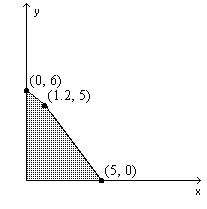Solve the problem. Be sure to make a diagram of the situation with all the given information labeled.
?
The diagonal of a rectangle is 354 millimeters, while the longer side is 274 millimeters. Find the shorter side of the rectangle and the angles the diagonal makes with the sides.
?
Round the side length to the nearest millimeter. Round the angles to the nearest degree.
?
A. The side is 224 mm; the angles are 59° and 31°.
B. The side is 213 mm; the angles are 59° and 31°.
C. The side is 213 mm; the angles are 51° and 39°.
D. The side is 224 mm; the angles are 51° and 39°.
E. The side is 224 mm; the angles are 56° and 34°.
Answer: D
You might also like to view...
Use fractal geometry to determine the answer.Consider a square with edges of length seven. Suppose that four of these squares are placed edge to edge to form a new larger square. What is the length of each edge of the new larger square?
A. 20 B. 49 C. 14 D. 2
The graph shows a region of feasible solutions. Find the requested value or values of P over this region.Find the maximum and minimum ofP = 13x - 16y.
A. -96, 0 B. 65, 0 C. 65, -96 D. -63.75, -96
If the following is a polynomial function, then state its degree and leading coefficient. If it is not, then state this fact.f(x) = 
A. Degree: 3; leading coefficient: 4 B. Degree: 12; leading coefficient: 3 C. Degree: 4; leading coefficient: 3 D. Not a polynomial function
Draw a unit circle centered at the origin and sketch ?A = 180°. Label as P where the side of A, not on the x-axis, intersects the unit circle. Find and label the coordinates of P on the unit circle.
What will be an ideal response?